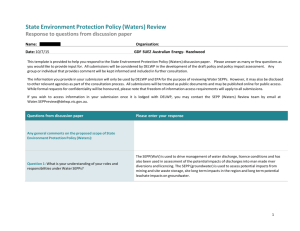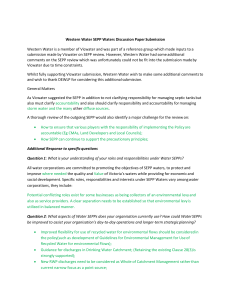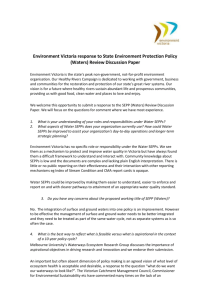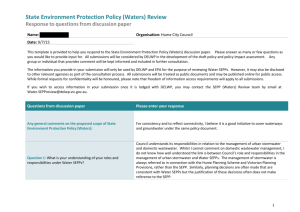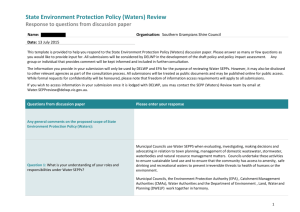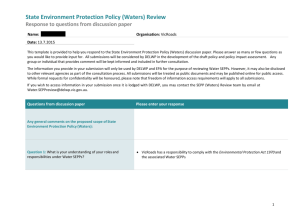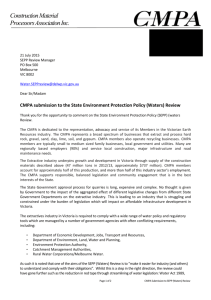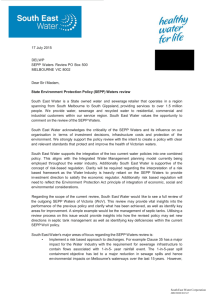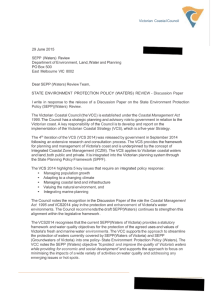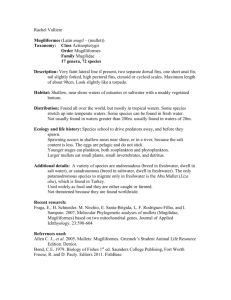GHD (Accessible version) [MS Word Document
advertisement
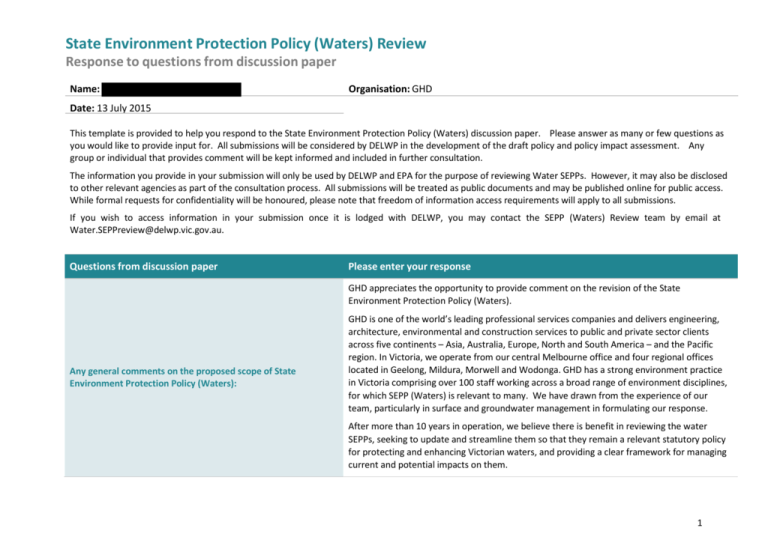
State Environment Protection Policy (Waters) Review Response to questions from discussion paper Name: Organisation: GHD Date: 13 July 2015 This template is provided to help you respond to the State Environment Protection Policy (Waters) discussion paper. Please answer as many or few questions as you would like to provide input for. All submissions will be considered by DELWP in the development of the draft policy and policy impact assessment. Any group or individual that provides comment will be kept informed and included in further consultation. The information you provide in your submission will only be used by DELWP and EPA for the purpose of reviewing Water SEPPs. However, it may also be disclosed to other relevant agencies as part of the consultation process. All submissions will be treated as public documents and may be published online for public access. While formal requests for confidentiality will be honoured, please note that freedom of information access requirements will apply to all submissions. If you wish to access information in your submission once it is lodged with DELWP, you may contact the SEPP (Waters) Review team by email at Water.SEPPreview@delwp.vic.gov.au. Questions from discussion paper Please enter your response GHD appreciates the opportunity to provide comment on the revision of the State Environment Protection Policy (Waters). Any general comments on the proposed scope of State Environment Protection Policy (Waters): GHD is one of the world’s leading professional services companies and delivers engineering, architecture, environmental and construction services to public and private sector clients across five continents – Asia, Australia, Europe, North and South America – and the Pacific region. In Victoria, we operate from our central Melbourne office and four regional offices located in Geelong, Mildura, Morwell and Wodonga. GHD has a strong environment practice in Victoria comprising over 100 staff working across a broad range of environment disciplines, for which SEPP (Waters) is relevant to many. We have drawn from the experience of our team, particularly in surface and groundwater management in formulating our response. After more than 10 years in operation, we believe there is benefit in reviewing the water SEPPs, seeking to update and streamline them so that they remain a relevant statutory policy for protecting and enhancing Victorian waters, and providing a clear framework for managing current and potential impacts on them. 1 State Environment Protection Policy (Waters) Review Response to questions from discussion paper The SEPP (Waters) Review discussion paper provides some good information on the DELWP’s and EPA’s early thinking of how to refine the water SEPPs. We are supportive of the following suggested amendments: Looking to streamline the SEPPs while keeping the fundamentals unchanged (use of segments, beneficial uses, environmental quality objectives) The inclusion of feasible objectives to define what should be achievable within the 10year policy cycle The need to strike a balance between beneficial uses and economic and social development The proposed development of a separate SEPP (Waters) Implementation Plan to drive the implementation of activities to meet SEPP objectives in priority areas From our experience in applying the water SEPPs to the work we do for our clients, we also believe the following areas of improvement should be considered to make SEPP (Waters) more practical to apply and help in achieving its objectives: Provide greater guidance on how the quality of discharges to receiving waters should be managed to meet SEPP objectives and not compromise beneficial uses Include other measures for groundwater classification, such as groundwater yield and type of salts present for example, other than TDS Review marine segment boundaries to consider hydrodynamics, ecological diversity and catchment water quality inputs Reassess the list of beneficial uses once the groundwater and surface water SEPPs are amalgamated to remove duplication and ensure it is sensible Provide clarity and transparency in derivation methods applied for the objectives Consider stygofauna for inclusion as an indicator of groundwater health GHD values the opportunity to provide this response to DELWP for consideration. We hope it will be useful and look forward to ongoing participation in the review of the SEPP (Waters). 2 State Environment Protection Policy (Waters) Review Response to questions from discussion paper Question 1: What is your understanding of your roles and responsibilities under Water SEPPs? As consultants, GHD’s role is to assist clients in understanding their responsibilities under the SEPPs both in relation to ongoing environmental compliance and proposed activities they undertake in the course of operating their business. This could be an assessment of contaminated land, discharge to surface water or the design and operation of irrigation and dryland related surface and subsurface drainage works. For GHD, the main sections that are frequently referenced and reviewed are the policy principles, beneficial uses, the indicators and objectives and Clause 19 Polluted groundwater zones in the Groundwater SEPP. Some suggested improvements include: Question 2: What aspects of Water SEPPs does your organisation currently use? How could Water SEPPs be improved to assist your organisation’s day-to-day operations and longer-term strategic planning? • Better alignment of the SEPP with ANZECC guidelines. For example, Part VII, Schedule A, clause A1(1) on page 30 of the SEPP does not align with the percentage level of ecosystem protection in Table 3.4.1 in the ANZECC guidelines (see notes about the grey boxes in the ANZECC guidelines and terminology about different levels of ecosystem protection). • Clarification around water quality requirements of water discharged into an already degraded surface water. It is understood that if background water quality levels in the receiving waters are above SEPP, there are no requirements to improve the quality of the water being discharged beyond those background levels. Should there be a catchment context that needs to be taken into consideration in these circumstances? Also, in a degraded environment, the biological monitoring is not sensitive enough to pick up changes. Clarification on when biological monitoring is required. • Question 3: Do you have any concerns about the proposed working title of State Environment Protection Policy (Waters)? If so, what are they? Both the groundwater and surface water SEPPs contain the word “Victoria” in its title (i.e. Groundwaters of Victoria and Waters of Victoria). It would be useful to retain this state designation to highlight that this is Victorian specific legislation. 3 State Environment Protection Policy (Waters) Review Response to questions from discussion paper Question 4: What is the best way to reflect what is feasible versus what is aspirational in the context of a 10-year policy cycle? It would be important to be clear and provide definitions of what feasible and aspirational mean, particularly in terms of timelines. Establishing numerical environmental quality objectives for feasible and aspirational objectives would also provide clear guidance on what magnitude of change is required to protect and enhance beneficial uses. The attainment program and implementation plan should then set out what is required to achieve the feasible objectives over the 10 year life of the SEPP, and the aspirational targets over the a longer timeframe, which should be defined (say 25 years). This is likely to require significant community consultation, and a clear understanding of the costs and benefits of achieving both the feasible and aspirational targets. The process for developing the feasible and aspirational objectives, how they should be used and when they should be attained should be clearly documented in supporting documentation or guidelines. Question 5: Do you support the proposed SEPP (Waters) objective of “this policy is to protect and improve the quality of Victoria’s waters while providing for economic and social development”? Why? Is this not covered as part of the need to protect “beneficial uses”? Should the objective be reworded:- “this policy is to protect and improve the quality of Victoria’s waters and their beneficial uses whilst balancing the need for economic and social development”? Again, feasible and aspirational objectives and their attainment requirements need to be clearly stipulated. Question 6: Do you support the need to balance economic and social development with overall protection and improvement of water quality for Victoria’s water environments? Why? Yes, but it should be dealt with on a case by case basis as the balance between economic/social development and water quality can be complex and dependent on the scenario. A triple bottom line approach, based on risk to environment/economy/society, would be a good approach to achieving a balanced outcome. Question 7: What are the challenges of balancing economic and social development with protecting and improving water quality? How should we manage the appropriate trade-offs between them? As discussed above, a triple bottom line approach based on risk should be developed to support decision making related to the SEPP. The incorporation of the use of offsets may be a way to facilitate the achievement of a balance, whereby the impact to water quality is offset by investment in another area that lead to a net increase in environmental quality or an overall enhancement to beneficial uses.. For example, to offset the nutrient component of a wastewater treatment plant effluent discharge into a waterway, stormwater treatment in a neighbouring urban centre could be implemented to reduce nutrients entering the waterway, as described in the Water Quality Offsets Framework by Alluvium (2015). 4 State Environment Protection Policy (Waters) Review Response to questions from discussion paper Question 8: Do you foresee any problems or opportunities that may arise from creating one consistent SEPP to apply to all Victorian waters? Are there other options for streamlining the policies that we should consider? Question 9: Are there any specific types of water environments, for example, a wastewater treatment lagoon, where you think beneficial uses should not be protected? GHD acknowledges that the consolidating of the groundwater and surface water SEPPs would be beneficial. However, care must be taken when combining the two SEPPs to avoid: • Increasing the difficulty or burden when updating the larger, more complex policy which may lead to more of reluctance to make changes. • Increasing complexity of the document to read, understand, achieve consistent interpretation and update. Stormwater retarding basins and evaporation basins could be types of water environments where beneficial uses should not be protected. However, instead of specifying individual types of environments for exclusion, GHD supports the current SEPP clauses that describes where beneficial uses are not protected: (1) in circumstances where the background level would not provide for their protection; (2) in artificial stormwater drains, artificial agricultural drains, artificial irrigation channels and drains or artificial wetlands (see clauses 46 and 51). These artificial environments need to be managed for the purposes for which they were constructed and must be designed and managed so that they are not harmful to humans or have unacceptable impacts on animals, and so that their impact on surface waters is minimised. Although beneficial uses are not protected in these artificial environments, it is not acceptable to dump or illegally discharge wastes into them. 5 State Environment Protection Policy (Waters) Review Response to questions from discussion paper Question 10: Do you think the current measures for classifying surface water and groundwater segments are still appropriate? Are there other measures that should be explored? The incorporation of an urban segment is useful for surface waters but consideration should be given to expanding it to cover Melbourne’s extended metropolitan area and the urban areas outside the Melbourne metro area where certain beneficial uses may not be appropriated. For example the Yarrowee River runs through Ballarat and receives most of the stormwater flows in this regional urban centre. In terms of groundwater, due to advancements and decreasing cost in desalination technology, managing water salinity is becoming less definitive in assigning beneficial use in groundwater. For example, the TDS for a particular groundwater could be categorised as Segment D due to high salinity. Under that segment, the beneficial uses that are protected are “industrial water use” and “buildings and structures”. However, someone could extract the water, desalinate it and use it for stock watering. Therefore, protection of these beneficial uses may not be captured. In drafting the new SEPP, consideration needs to be given to cost effective technologies for groundwater desalination that may affect how beneficial uses are designated. Groundwater yield, related desalination costs and the type of salts present may be more relevant. What is being protected will also need to be clearly defined. The groundwater segments should better align with council zonings. For example, stock water should not be a protected beneficial use in urban areas where keeping stock is not permitted under council by-laws. Bores registered for stock watering in these areas have generally long since been abandoned. Question 11: Are there any problems with the spatial arrangements or segment boundaries in the existing Water SEPPs? If so, what are they? The segments boundaries for marine areas (namely Western Port and Port Phillip Bay) need to be reconsidered to reflect the hydrodynamics and ecological diversity of these areas and catchment input to them. GIS based mapping of segments and sub-segments should be made available as per current segments. 6 State Environment Protection Policy (Waters) Review Response to questions from discussion paper Question 12: What do you think are the advantages or problems with the new approach to segments and sub-segments? Based on the case study, the new classifications seem simpler to use. However, some clarity around the definition for the designation of area as a sub-segment would be helpful. For example perhaps it would be clearer if: • examples of what can be included in sub-segments were added. • it was explained that: o they are only used when additional segregation is required o They do not cover the whole catchment. Question 13: Are there any features of the landscape that you would like to see as a standalone segment or sub-segment? Irrigation Districts where surface drains and water recycling occurs. Yes, but :• Question 14: Do you believe that all beneficial uses set out in Table 2 of the discussion paper should still be protected under the new SEPP (Waters)? Where do you think a beneficial use would not apply? Why? • • • • • Question 15: What method or approach could be used to apply the beneficial uses to segments and sub-segments? why are “passage of indigenous fish” and “maintenance of indigenous riparian vegetation” only required in the Yarra catchment? Some amalgamation of beneficial uses could be considered, i.e. human consumption and potable water supplies, and “agriculture and irrigation” and “Agriculture, parks and gardens”. Marine/estuaries could be used for potable water supply after desalination. Rivers and wetlands in addition to groundwater are all sources of stock water Groundwater as well as rivers and wetlands are suitable for “Human Consumption after appropriate treatment”. Groundwater should be included in agriculture and irrigation. No comment. 7 State Environment Protection Policy (Waters) Review Response to questions from discussion paper Question 16: Are there any additional beneficial uses that you believe should be protected? Are there any that you think should no longer be protected? Why? Not that GHD is aware of. Question 17: What do you think about the current indicators, the approach for deriving objectives and the proposed changes? The current indicators are suitable. However, the addition of Victorian specific toxicants would be useful. Consistency of definitions between SEPP and ANZECC guidelines as per response to Question 2 would be useful and avoid confusion (i.e. how modified the ecosystems are). It should be noted that changing the types of organisms and/or methods for quantifying biological indicators may not lead to an improvement in sensitivity over existing methods and add value. A broader suite of appropriate tests could be provided so that the most appropriate method can be used to define the health of a particular waterway. Stygofauna should be considered for inclusion as an indicator of groundwater health. GHD understands that this may be problematic due to the lack of Victorian based data in terms of their distribution and environmental requirements or tolerances. In terms of objectives derivation, there needs to be clarity and transparency in the approach taken (i.e. methods used for derivations) and access to supporting scientific documents. While the water quality objectives are set for the a 75th percentile, there is uncertainty around the impact of a single discharge event of a water quality exceeding SEPP objective. A discussion needs to be included around acute and chronic guideline values, and how they affect aquatic ecosystems. There is not much discussion on what happens during flood flows when concentrations are typically high compared to low flow times, and how these short term high concentrations affects aquatic ecosystems. This may have implications for the management of short term wastewater treatment plant discharges which may cause temporary high concentrations in a receiving water. 8 State Environment Protection Policy (Waters) Review Response to questions from discussion paper Question 18: How have nutrient load targets been useful in driving environmental investment outcomes? Would you like to see a different approach, and if so, what might that be? The nutrient load approach has helped focus efforts (by the water authorities) in the Goulburn Broken Catchment of the River Murray, the Macalister catchment of the Gippsland Lakes and Port Phillip Bay. This is evidenced by the design approach taken to install high flow diversion storages in the Shepparton Irrigation Region. This is also reflected in the approach to financially encourage the construction of on-farm reuse systems in Goulburn Murray and Macalister Irrigation District to reduce and retain nutrient in order to reach resource condition targets which were set considering SEPP. A load based approach is easier to manage in terms of cause and effects relationships because in most areas, this is flow driven. The use of concentration based nutrient limits for diffuse source management is resource intensive to monitor and manage. That is, data to support the use of load based targets is easier and less expensive to monitor. An example of this is fertiliser management and the uncertainty of how fertilizer application, which may vary markedly across a catchment, relates to nutrient concentration in runoff and the accumulation of nutrient mass from a number of sources over time to determine diffuse source nutrient concentrations. Question 19: What is the preferred method for management of at-risk areas? Are there activities that need greater intervention or regulation? What would the intervention be, for example, voluntary or mandatory codes of practice, regulation via licensing? Similar to what is proposed, “at risk areas” should be identified by water quality triggers that relate to the beneficial uses for the waterway/groundwater in question. Interventions should initially be voluntary, possibly under the Catchment and Land Protection Act with regulations being used in extreme cases, where community needs and expectations are not being voluntarily met by the responsible body. However, what is to be done with areas that already exceed current “trigger” levels? Should the same approach apply? Clearly defining how to identify and deal with areas designated as “at risk” should be included in the SEPP (Waters) Implementation Plan. 9 State Environment Protection Policy (Waters) Review Response to questions from discussion paper Question 20: What do you think the role of SEPP (Waters) should be in identifying and filling knowledge gaps over the life of the policy? How can we assure an adaptive approach within SEPP (Waters)? It is important that the SEPP (Waters) identifies current knowledge gaps, sets targets for meeting these gaps and includes a process of continuous improvement that is transparent. As time passes, the knowledge gap database should be updated to ensure that at the end of the 10 year life of the SEPP, the gaps remaining at the time are known. Expectations on achieving targets for filling these gaps should be subject to funding being available. The register of work required to fill the knowledge gaps should also be prioritised on a benefit:cost risk basis. For example, research associated with “at risk” areas with high economic or community impact may have a higher priority. It is also important to consider various funding and cost share models (i.e. levies, fines, offsets, taxes, donations) and how assistance from a range of parties (i.e. industry, community groups, local councils, CRCs and state and federal governments) could contribute either financially, in-kind or intellectually. Any other information you would like to share: 10
